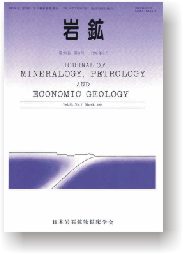All issues

Volume 90, Issue 12
December
Displaying 1-3 of 3 articles from this issue
- |<
- <
- 1
- >
- >|
REVIEW
-
II. Origin of felsic rocks in IcelandAkio MAKISHIMA1995Volume 90Issue 12 Pages 413-418
Published: 1995
Released on J-STAGE: December 13, 2006
JOURNAL FREE ACCESSThe isotope geochemical study for Iceland is reviewed. Iceland yields not only tholeiitic basalts but also tholeiitic andesites or rhyolites. Many geochemical studies were done to decipher the origin of the felsic volcanic rock which constitutes about 10% of the Icelandic crust. However, the origin was not clear. To solve this problem, the combination of Sr, Nd, Pb, He and O isotope tracers with U-Th disequilibrium has been attempted, and the involvement of the Icelandic hydrothermally altered crust into the source of the felsic rock is infered. In near future, application of new Li and B tracers will constrain the origin of the felsic rock in more detail.View full abstractDownload PDF (794K)
ORIGINAL ARTICLES
-
Masumi UJIIE, Noboru IMAI1995Volume 90Issue 12 Pages 419-427
Published: 1995
Released on J-STAGE: December 13, 2006
JOURNAL FREE ACCESSAcid digestion and alkali fusion were applied to sample preparation of granitic rocks for the rare earth elements (REE) analysis by inductively coupled plasma mass spectrometry (ICP-MS). Granitic rock samples were decomposed by conventional rock-dissolution techniques, and the residues were fused with the mixture of Na2CO3 and H3BO4. The fusion ensured complete dissolution of acid-resistant minerals. Appropriate amounts of major elements were added to the REE calibration standard solution for matrix matching. The conditions of the instrument were adjusted to minimize the formation of the oxide molecular ions. Fourteen REE in three standard samples of granitic rocks were determined successfully.View full abstractDownload PDF (1081K)
SHORT NOTE
-
Yoshiaki TAINOSHO, Shoji SHINBA, Sadao YASUMATU, Etuko KODERA1995Volume 90Issue 12 Pages 428-432
Published: 1995
Released on J-STAGE: December 13, 2006
JOURNAL FREE ACCESSWe have investigated the distribution and properties of the ground surface deformations, which were caused by the Hyogoken-nanbu earthquake, in the southeastern area of the Rokko Mountains, eastern part of Kobe city in Japan. The landforms of the study area are characterized by foot of Rokko Mountains formed by the weathered granitic rocks. The Otuki fault in this area is running parallel to the mountain foot from NE to SW. The ground surface deformations appear to be concentrated along the Otuki fault. Many mountain slope failures were collapsed on the Otuki fault. The reason for these slope failures distribution are thought to be strong ground motion by Hyogoken-nanbu earthquake. The upper parts of the mountain slope failures have broken by tension fractures of NE-SW.View full abstractDownload PDF (3270K)
- |<
- <
- 1
- >
- >|